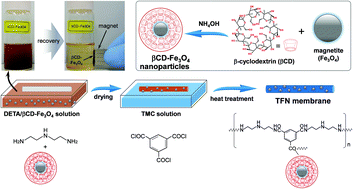Recyclable βCD-Fe3O4 nanoparticles are successfully synthesized by the co-precipitation method and incorporated into thin-film polyamide membranes by interfacial polymerization reaction between diethylene triamine (DETA) and trimesoyl chloride (TMC) on the surface of polysulfone (PSf) hollow fibers, forming thin-film nanocomposite (TFN) membranes. The structural and morphological features of the synthesized nanoparticles and fabricated TFN membranes are characterized using various techniques. The high-resolution transmission electron microscopy (HR-TEM) mapping data show that the core of the nanoparticles consists of iron and oxygen and their shells are surrounded by βCD. The energy dispersive X-ray (EDX) data reveal that the iron content increases from 0 to 0.07 atomic% when the βCD-Fe3O4 loading increases from 0 to 1.0 wt%. Water vapor/nitrogen gas permeation tests indicate that the addition of nanoparticles in the polyamide membranes increases the water vapor permeation due to the enhanced sorption sites and surface area provided by the nanoparticles. The best performance of TFN membranes includes a water vapor permeance of 2237 GPU and a water vapor/nitrogen selectivity of 774 when the content of βCD-Fe3O4 nanoparticles is 0.2 w/w% with respect to the DETA monomer. Further research on these βCD-Fe3O4 nanoparticles can potentially lead to a promising candidate material for water vapor separation membranes.
